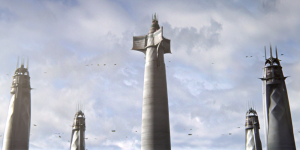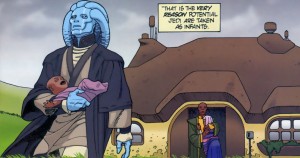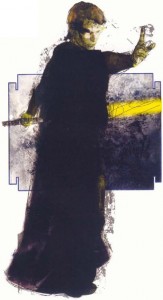 Welcome back to part 3 of our mini-series of weekly post about my Star Wars Infinities Campaign: Episode I, The Gathering Storm. You can find the first and second post by clicking the links; there you can find more information about what this mini-series of posts is all about. Hope you enjoy it. Looking forward to your comments…
Welcome back to part 3 of our mini-series of weekly post about my Star Wars Infinities Campaign: Episode I, The Gathering Storm. You can find the first and second post by clicking the links; there you can find more information about what this mini-series of posts is all about. Hope you enjoy it. Looking forward to your comments…
History of the galaxy and the Jedi Orders – Part 2
A thousand years ago, with the Republic having reached its current extent and configuration, conflict began to brew from within. The Republic had grown to a size and might unheard of in previous galactic civilizations. But controlling such a vast and complex government was not easy. The Republic was sluggish in its workings and increasingly relied on its military might to impose order. Many of the noble families whose ancestors had given up power long ago became disenchanted with the Republic. Old rivalries were reawakened, old wounds reopened, and systems began to fear the Republic would do away with the trappings of democracy and establish a military dictatorship.
In this time of crisis the Jedi Orders met in Council and agreed that they needed to intervene to maintain peace and preserve the Republic. The Jedi Orders mediated the Coruscant Accord, a compromise that sought to appease all sides but ultimately satisfied no one.
 Under the Coruscant Accord planetary systems, sectors and political blocks within the Galactic Republic were given autonomy within their territory, the Republic demilitarized, dissolving its fleet and standing army as each system would in turn be responsible of creating their own regional defense forces. The Republic Senate instead of a policy making body, became a mediatory organization where disputes and conflicts could be solved peacefully. The Senate maintained a token space fleet to secure safe travel on hyperspace routes and assure free trade among the Republic’s member worlds and a small peace keeping force to mediate conflict as well to protect Coruscant.
Under the Coruscant Accord planetary systems, sectors and political blocks within the Galactic Republic were given autonomy within their territory, the Republic demilitarized, dissolving its fleet and standing army as each system would in turn be responsible of creating their own regional defense forces. The Republic Senate instead of a policy making body, became a mediatory organization where disputes and conflicts could be solved peacefully. The Senate maintained a token space fleet to secure safe travel on hyperspace routes and assure free trade among the Republic’s member worlds and a small peace keeping force to mediate conflict as well to protect Coruscant.
 At first the solution seemed to work, as independent systems and sectors took advantage of self-rule to maximize their potential and there was a boom in the Galactic economy. The Senate used what little remained of its influence to secure a series of treaties assuring the continuation of trade between the autonomous systems and the security of the Core Worlds. The Jedi Orders took and active role in this reconfiguration of the Republic, taking some systems and sectors under their wing as protectorates, mostly in the Outer Rim, to assure their continued survival. Growing tensions seemed to dissipate and peace once again swept the Republic, for a very short time.
At first the solution seemed to work, as independent systems and sectors took advantage of self-rule to maximize their potential and there was a boom in the Galactic economy. The Senate used what little remained of its influence to secure a series of treaties assuring the continuation of trade between the autonomous systems and the security of the Core Worlds. The Jedi Orders took and active role in this reconfiguration of the Republic, taking some systems and sectors under their wing as protectorates, mostly in the Outer Rim, to assure their continued survival. Growing tensions seemed to dissipate and peace once again swept the Republic, for a very short time.
The peace brokered by the Jedi slowly began to fall apart. Some sectors thrived while other poorer systems found themselves unable to support even their basic needs. Trade tariffs paid to the Senate were insufficient to support those in need and an increasing number of services once assured and supplied by the Republic became privatized and fell under the control of the more powerful systems and corporations.
As the Republic continued its downward spiral, the Jedi also suffered. Blamed by many for the fracturing of the Republic the Orders faced other trials and tribulations. Over the last thousand years the number of Force sensitive beings dwindled, and those rare few born with the gift of the Force found little use or prestige in joining the Orders, many remaining untrained.
As their last masters passed away some Orders disappeared completely. The remaining Orders tried to save their traditions in different way. The militaristic Leoco Actum initiated a strict eugenics program to assure the birth of a new generation of Jedi. Their members were evaluated and matched up with other candidates in hopes that their offspring would prove strong in the Force.
Among the contemplative Sar’Akar some members were convinced that the reason those sensitive to the Force no longer sought training was because of a lack of understanding among the citizens of the Republic of the Force and the traditions of the Jedi. This group of Sar’Akar sought to enlighten the Republic and began a campaign to educate and teach others about the Force.
The efforts of these Sar’Akar had the effect of presenting the idea of the Force and its possibilities to large numbers of people, but with so few Jedi dedicated to this endeavor, their ideas were soon twisted and perverted. Many focused only in the power of the Force, not the teachings or traditions that gave it purpose; others misinterpreted the message and attributed to the Force erroneous mystic qualities and divisive religious undertones, coming to almost worship Force users such as the Jedi. These heresies were dangerously close to the teachings of the Dark Side and when those leaders that begun the movement tried to control it, they discovered it was out of their hands. Others had taken the cause.
Likewise the Leoco Actum found that after generations their eugenic program was not successful at all as even the children born to their most powerful members proved to have limited powers or even no ability with the Force! This resulted in many Leoco Actum taking concubines after their arranged and loveless marriages proved unfruitful, some seeking love and companionship, others children strong in the Force. This Order also reestablished the practice of masters adopting their apprentices into their extended families, creating warrior clans composed of beings often of different species, and seeking out Force sensitive beings at an increasingly younger age.
Those that promulgated the twisted heresies that had been the Sar’Akar’s message became known as Force Petitioners. At first these groups mostly attracted beings without the ability to use the Force but obsessed with its might and power. Eventually their numbers attracted young inexperienced Jedi that ignored the warnings of the Sar’Akar and the Leoco Actum of the dangers of the Dark Side, and were instead seduced by the adoration and admiration of the Petitioners. Something most Jedi had not had for centuries.
 Using the power of Seers that could predict the potential of young children with the Force, the leaders of the militaristic Leoco Actum Order approved of reviving an ancient tradition. The Order began to seize children to be trained in their infancy, with the consent of the parents, if it could be obtained, without it otherwise. This caused no end of conflicts with local governments and family members opposed to the action. Even then the measure was not a complete success as some of those selected proved to have limited skills with the Force. These became lesser Leoco Actum, followers of the powerful Jedi Knights.
Using the power of Seers that could predict the potential of young children with the Force, the leaders of the militaristic Leoco Actum Order approved of reviving an ancient tradition. The Order began to seize children to be trained in their infancy, with the consent of the parents, if it could be obtained, without it otherwise. This caused no end of conflicts with local governments and family members opposed to the action. Even then the measure was not a complete success as some of those selected proved to have limited skills with the Force. These became lesser Leoco Actum, followers of the powerful Jedi Knights.
The splintered Force Petitioners grew in numbers and influence, acquiring protectorates and slowly coalescing into confederacy of systems with a small fleet. When their leaders began to prosecute and condemn other beliefs within their holdings the other Orders could stand it no longer. The few remaining Orders met in Council again, after decades of absence from the temple at Coruscant, and guided by the Sar’Akar and the Leoco Actum declared the Force Petitioners heretics and followers of the Dark Side.
 The Force Petitioners responded in earnest attacking the other Orders and their holdings. The contemplative Sar’Akar proved a difficult target to hit as many of their protectorates were distant from any hyperspace route, many of their temples hidden in faraway often uncharted planets. On the other hand the militaristic Leoco Actum were a much easier target, their protectorates more accessible, and most major training camps and shipyards well known and accessible. Many of the Leoco Actum’s younger students were imperiled. The Leoco Actum placed their pupils under the Sar’Akar’s care for protection and mounted a campaign against the Force Petitioners. Composed of mostly religious zealots but with few real Jedi in their midst, the Force Petitioners were finally vanquished by the Leoco Actum.
The Force Petitioners responded in earnest attacking the other Orders and their holdings. The contemplative Sar’Akar proved a difficult target to hit as many of their protectorates were distant from any hyperspace route, many of their temples hidden in faraway often uncharted planets. On the other hand the militaristic Leoco Actum were a much easier target, their protectorates more accessible, and most major training camps and shipyards well known and accessible. Many of the Leoco Actum’s younger students were imperiled. The Leoco Actum placed their pupils under the Sar’Akar’s care for protection and mounted a campaign against the Force Petitioners. Composed of mostly religious zealots but with few real Jedi in their midst, the Force Petitioners were finally vanquished by the Leoco Actum.
The aftermath of this conflict would forever shatter the Jedi Orders. The leaders of the Leoco Actum culled from the Petitioners the tainted Jedi and the most dangerous members, but did not want to stop there, instead calling for their complete annihilation. The Sar’Akar opposed this measure, and holding the children and young apprentices of the Leoco Actum under their protection as hostages, negotiated for the Petitioners to be banished to the Outer Rim.
By the same token the Leoco Actum refused to abandon the systems and sectors conquered in their campaign against the Force Petitioners, declaring them their protectorates and redoubling their efforts to recruit those young children born with the gift of the Force in these systems. The impasse over the Sar’Akar’s actions to save the Force Petitioners and the Leoco Actum’s expansionistic policies created the great schism that irrevocably splintered the Jedi Council. The temple at Coruscant abandoned for the last twenty five years.
Over time the citizenry has become disenchanted and jaded. They have realized the changes made to ensure the survival of the Republic had instead slowly undermined its accomplishments and stability. Many blame the Jedi for this, and long for the past glories of the Galactic Republic. They have turned to their leaders and found them unresponsive, preoccupied instead with petty rivalries, phantom threats and unrestrained armament build ups. Trade and commerce have dwindled; pirates and privateers ply the hyperlanes and out in hyperspace ships have begun to disappear.
Next week: A piece of fiction set in this background, Unexpected Guests! See you then…
Remember, Star Wars, all associated characters and images, are copyright of Lucasfilm and I use them here only as a fan creating an RPG campaign.
